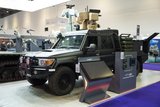Exelis, UrsaNav, USCG research eLORAN
Exelis, UrsaNav, the US Coast Guard and the Department of Homeland Security Science and Technology Directorate have entered into an agreement to test and demonstrate eLORAN, Exelis announced on 22 May.
The Cooperative Research and Development Agreement (CRADA) will see the team test and demonstrate eLORAN at former LORAN-C sites. These sites have the infrastructure of the decommissioned LORAN-C ground-based radio navigation service, with the capacity to be retained and upgraded for providing the eLORAN low frequency service.
The team will evaluate eLORAN as a possible complimentary system to the GPS system used widely in the US. The potential utilisation and capabilities of this service will be explored in-depth, and its potential vulnerabilities, capacities and strengths will be identified.
Under the CRADA, Exelis will use the LORAN-C sites to transmit eLORAN signals and research, test and demonstrate eLORAN's ability to meet the Positioning, Navigation and Timing (PNT) requirements of government and private critical infrastructure. Exelis will first broadcast signals from the station in Wildwood, New Jersey, with a usable range of up to 1,000 miles.
Ed Sayadian, vice president of civil and aerospace systems, Exelis, said: 'eLORAN is an ideal technology to complement GPS for critical, resilient and assured PNT.
'eLORAN is a difficult to disrupt technology that offers PNT and wide area broadcast data capabilities indoors, in underground locations and other GPS-denied environments.'
Chuck Schue, president and CEO, UrsaNav, said: 'A preponderance of government, academic, and industry reports have concluded that eLORAN is the best independent, multi-modal solution to provide assured PNT as a complement to GPS.'
More from Digital Battlespace
-
![Babcock nears first customer for Nomad AI translation tool]()
Babcock nears first customer for Nomad AI translation tool
Nomad can provide militaries with real-time intelligence, saving critical time on the battlefield.
-
![AUSA 2025: Israel’s Asio Technologies to supply hundreds of improved Taurus tactical systems]()
AUSA 2025: Israel’s Asio Technologies to supply hundreds of improved Taurus tactical systems
Taurus operates alongside the Israel Defense Forces’ Orion system which supports mission management across tens of thousands of manoeuvring forces, from squad leaders to battalion commanders.
-
![AUSA 2025: Kopin pushes micro-LED plans as China moves faster]()
AUSA 2025: Kopin pushes micro-LED plans as China moves faster
The plan for the new displays follows fresh investment in Kopin’s European facilities by Theon and an order for head-up displays in fielded aircraft, with funding from the US Department of Defense.
-
![AUSA 2025: Persistent Systems to complete its largest order by year’s end]()
AUSA 2025: Persistent Systems to complete its largest order by year’s end
Persistent Systems received its largest ever single order for its MPU5 devices and other systems earlier this month and has already delivered the 50 units to the US Army’s 4th Infantry Division.
-
![Aselsan brings in dozens of companies and systems under the Steel Dome umbrella]()
Aselsan brings in dozens of companies and systems under the Steel Dome umbrella
Turkey has joined the family of countries attempting to establish a multilayered air defence system with government approval in August 2024 for the effort landed by Aselsan. Dubbed Steel Dome, the programme joins Israel’s Iron Dome, the US Golden Dome, India’s Mission Sudarshan Chakra and South Korea’s low-altitude missile defence system.
-
![DSEI 2025: MARSS unveils new agnostic multidomain C4 system]()
DSEI 2025: MARSS unveils new agnostic multidomain C4 system
MARSS’ NiDAR system has been deployed using sensors from static platforms to provide detection and protection for static sights, such as critical infrastructure, ports and military bases.




























